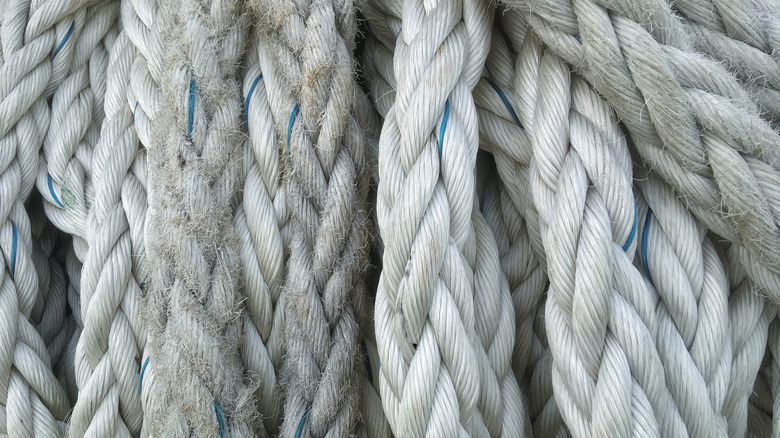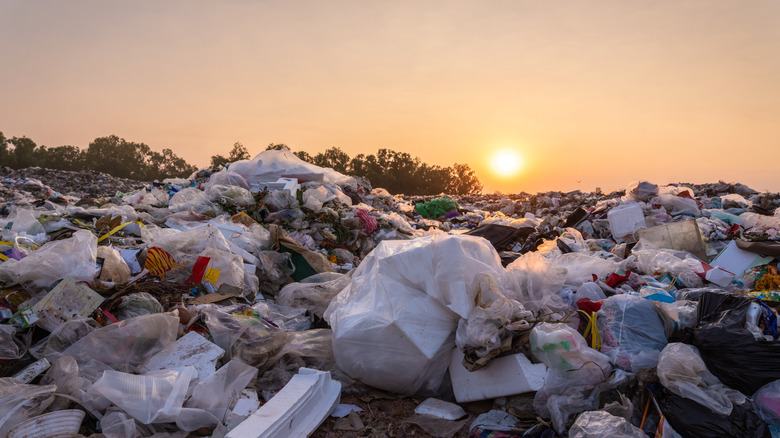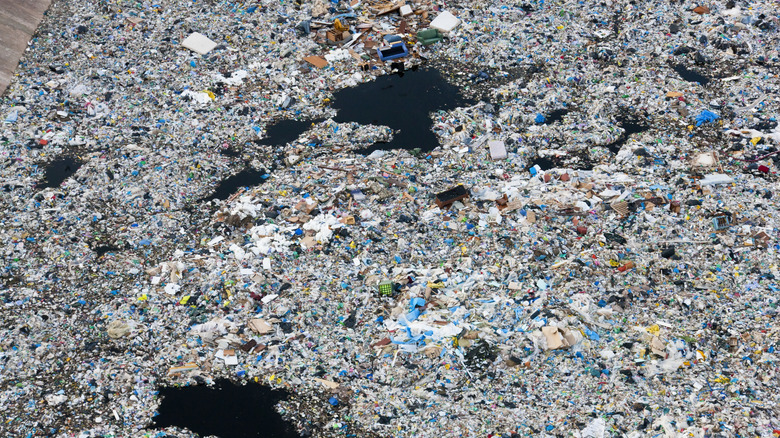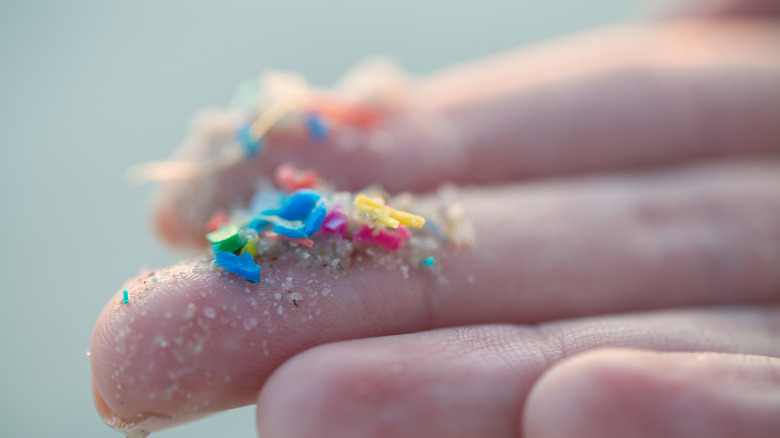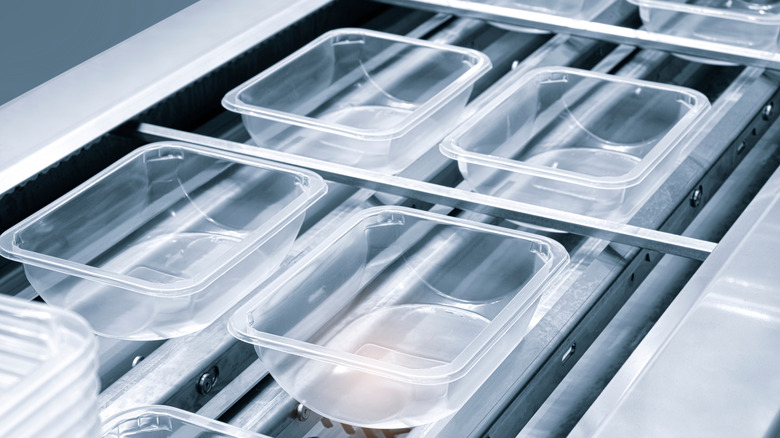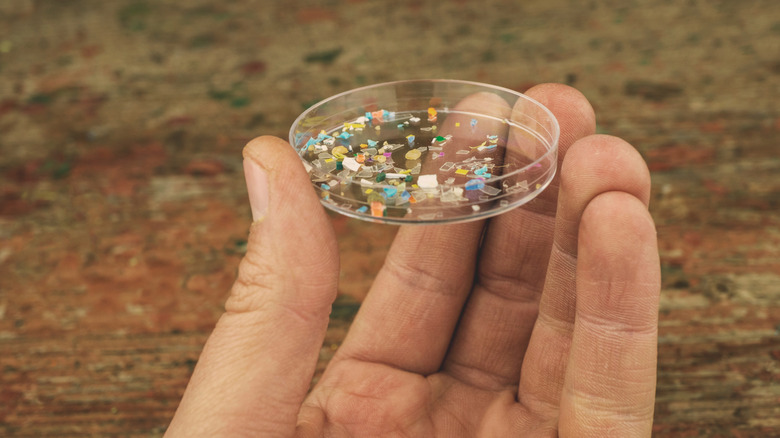The Revolutionary Invention That Became A Global Curse
There are many aspects of modern life that make it distinct from that of generations living around a century ago. As well as huge improvements in technology and air quality and aesthetic shifts in fields such as architecture, one of the biggest changes over the last 100 years has been a radical change in the materials we use to make everyday items, luxury goods, modern devices, and more.
This is thanks to the advent of plastic, the modern form of which first came into being at the start of the 20th century. Since then, it has been used in everything from food packaging and toys to clothing and military equipment. Without it, many of the objects we know today would be impossible to manufacture. Buy something new in a store or online, and chances are you will be buying plastic: either the object itself, or an aspect of the packaging in which it is sold to you.
But what was once hailed as a revolutionary invention that opened up a whole world of manufacturing possibilities has turned out in recent decades to have been a global curse. Not only is plastic now one of the planet's most pressing environmental disasters, damaging ecosystems and wildlife, it also represents a major public health risk for human beings for whom plastic use and everyday life are increasingly inseparable.
Early plastics
Things have changed a great deal since the 19th century, when the precursors to modern plastics first came into use. Among them were materials like natural rubber, invented in 1839, and shellac, a natural material derived from the shells of beetles, which was invented in 1856. The Victorian era also saw the creation of the first semi-synthetics, with super-light polystyrene developed in Germany by accident in 1839.
Some developments laid the groundwork for technological advances that would come to define the early part of the 20th century. For example, in 1869 John Wesley Hyatt invented celluloid, which was widely used as a cheap alternative to many natural products such as ivory and tortoiseshell, but was especially seismic for the entertainment industry, becoming the basis of film used to create motion pictures.
These are just a few examples. In reality, the 19th century saw the creation of several semi-synthetics, while the dawn of the 20th saw the arrival of the first thermosetting plastics and thermoplastics, many of which are still commonly used today.
The Bakelite revolution
The biggest leap in the production of plastics came in 1909, with the invention of the first true plastic, phenol-formaldehyde — a material that went on to be world famous via its brand name, Bakelite. It was named after its New York-based inventor, Leo Hendrik Baekeland, who had made his fortune in the 1890s with the creation of Velox photographic paper.
In the 1900s, Baekeland turned his attention to perfecting a replacement for beetle-derived shellac, which was becoming increasingly scarce. After years of experimentation, Baekeland perfected, through his steam-pressured "Bakelizer" machine, the ideal temperature at which to combine phenol and formaldehyde into a polymer that could then be combined with fillers. The result was a plastic that was both moldable and hard, and could be used for countless applications.
Baekeland would become hugely successful because of the new material, with the inventor filing a total of 400 patents over the course of his career and making himself immeasurably wealthy as a result. He was an openly capitalistic inventor; indeed, when asked what first turned his attention to the creation of what would become Bakelite, he admitted that his chief motivation was financial. But Bakelite itself wouldn't hold a monopoly in the world of manufacturing when it came to 20th century synthetic plastics.
The proliferation of synthetic plastics
A wide array of thermosetting plastics and thermoplastics followed the invention of Bakelite, many of which would go on to shape the look and texture of the modern world.
Synthetic polymers are all alike in the fact that they are manmade using a chemical reaction, which orders the building blocks of the polymer, known as monomers, in a repeat pattern. These monomers are usually carbon, and the polymers created in this manner occur nowhere else in nature. But while the simple science behind all synthetic polymers is almost identical, there is a vast array of different synthetic polymers that each have their own characteristics. They are separated into four groups: thermoplastics, thermosets, elastomers, and synthetic fibers, but they didn't all come along at once. Instead, individual polymers came into being during the course of the 20th century as a result of other inventors following in Bakelite creator Leo Baekeland's wake.
Polyvinyl chloride, or PVC, often referred to simply as vinyl, has been created as far back as 1872, but was almost useless until 1926, when Waldo Lonsbury Semon of the American B.F. Goodrich Company created and secured a patent on a plasticized version. Shortly after came polyvinylidene chloride, better known as Saran of Saran Wrap fame, which was discovered accidentally in a Dow Chemical lab in 1933, and low-density polyethylene, which was invented in 1935. Acrylic, polyurethane, polystyrene, and nylon would all arrive before the end of the decade, and countless others after that.
The uses of synthetic polymers in the modern world
Synthetic polymers are so prevalent because they are so useful, even if their potential isn't understood at the moment of their creation. For example, it would take Dow Chemical 20 years to introduce Saran Wrap to the market after the invention of Saran in 1933, despite the practicality of its use seeming obvious to us today.
Bakelite itself represented a revolution in how scientists thought about plastic materials. It revolutionized the automobile, aerospace and electronics industries, heralding a new era of modern technologies that would be unthinkable without the use of hard, durable plastic. New innovations in plastics were also driven by necessity. The late 1930s saw Western nations remilitarize as World War II dawned, creating a push to find new, hardy, reliable materials that could aid the war effort and fill the gaps where traditional materials were increasingly hard to come by. Nylon, invented in 1935, was first intended to be a synthetic alternative to costly silk but became a crucial material during the war to make military equipment such as parachutes and ropes. In the modern world, synthetic polymers are in everything from clothes to packaging, and play an important role in complicated machinery, surgical implants, and more.
The characteristics that make plastic dangerous for the environment
However, while synthetic polymers were heralded as a miracle at the start of the 20th century for exhibiting properties rarely seen in the natural world, the truth is that many of those same properties have meant the plastics industry has become an existential danger to the natural world. The plastics that have been used to make a great variety of everyday materials that are found in millions of households across the world are non-biodegradable, meaning they do not break down and decompose naturally into the environment through contact with bacteria, like the natural materials that predated them. Instead, it takes commonly used forms of plastic hundreds of years to decompose — during which time they cause an incredible amount of environmental damage.
The issue isn't just that plastics often aren't reusable and result in mountains of trash that won't disintegrate anytime soon. Their durability means that once they enter the environment, they stay there, blocking waterways — both natural and human-made — and affecting natural habitats. There is also the fact that when plastics do break down, the result is incredibly toxic. Some synthetic polymers release pollutants on contact with heat and sunlight, while burning plastic produces clouds of toxic smoke. Some synthetic materials release harmful chemicals, such as toxic copper salt, into the earth.
Plastic in our oceans
Perhaps the most shocking impact of the environmental crisis being caused by plastics is found in our oceans, where a great deal of what is manufactured ends up, causing untold damage to habitats and sea life. Plastic's durability and ability to be formed into almost any shape imaginable means that plastic refuse can become hazardous, especially to larger sea creatures and birds, who are liable to become entangled in pieces of plastic waste. Famously, several campaigns have focused on the damage caused by the plastic rings from six-packs of soda and beer cans, which can ensnare sea turtles and other animals, but animals can become entangled in all manner of plastic objects, including abandoned fishing gear and garbage.
More than that, the plastics can make their way into the creatures' bodies, after either being mistaken for food or inhaled, causing further physical damage. Plastic also releases chemicals that are leached into sea water, making it a toxic environment for sea creatures and destroying ecosystems such as coral reefs and all manner of underwater vegetation. Much of this occurs on a scale that could not be seen with the naked eye, but there is no denying the sheer amount of plastic that winds up in our oceans once you catch a glimpse of "The Great Pacific Garbage Patch," a floating conglomeration of mainly plastic pollution that covers a surface of the ocean twice the size of Texas. Such masses are brought together by ocean currents, and there are five such patches spread across the globe, of which the Pacific patch is the largest.
Microplastics in the human body
Just like the ocean, the human body is susceptible to plastic pollution, an aspect of modern life that is causing untold health problems for the population across the globe. As has become a major topic in public health discourse in recent years, one of the most worrying aspects of plastic pollution is the creation of microplastics: fragments of plastic that break off from larger objects and which continue to break into smaller and smaller pieces instead of decomposing as natural materials do. Microplastics have inundated the natural world, having been found in the deepest recesses of the ocean and even the peak of Mount Everest. More worryingly, however, we now know that microplastics are also found in the bodies of living organisms, having first been discovered inside plankton in the 1970s. They have since been identified in 1,300 species, including humans, and have been found in major organs including the human brain, heart, stomach, reproductive organs, and even the placenta.
With microplastics so prevalent in the bodies of living creatures, research is now ramping up to uncover just what effect these fragments have on our health. It is becoming increasingly clear that microplastics may be responsible for a wide range of health issues, including one 2024 study that showed an increased risk of heart attack, stroke, and death among heart patients found to have microplastic in the plaque found in their arteries. Plastic production includes the use of more than 10,000 chemicals, meaning a mountain of research is still required. Worryingly, the absorption of microplastics in the modern world seems to be inescapable, though reducing the use of plastics in the kitchen and reducing one's consumption of plastic-wrapped foods are believed to be some steps people can take to limit exposure.
The shocking stats around current plastic production
Considering the huge ecological and public health risks of plastics, it would seem obvious that their use in modern life would require a major rethink, with bold action needed to limit their use and to reduce their presence in the natural world and, through contamination, our own bodies. But sadly, the statistics show that worldwide plastic use seems to be trending in the other direction.
The world produced around 2 million tons of plastic back in 1950. Today, studies indicate we produce more than 450 million tons, 91% of which is not recycled. At the same time, the amount of plastic waste produced each year which then enters either landfill and the wider natural world continues to grow. The UN Environment Programme now estimates that more than 19 million tons of plastic enter the oceans, lakes, and rivers each year, the equivalent of 2,000 garbage trucks' worth every day. Experts say that one of the major issues in the plastics supply chain is mismanagement of waste. Recycling, safe landfill storage, and safe incineration of suitable plastics are the main ways for waste to be processed, but as yet around a fifth of the plastic produced in the world does not end up treated in one of these ways.
Radical attempts to clear the ocean
Improving waste management is considered one of the key ways to fight growing plastic pollution, though other experts believe that more radical solutions are now required. Thankfully, some organizations are already well underway with their efforts to clean up the mess we have already made, particularly in the ocean.
The Ocean Cleanup is a project aimed directly at cleaning up the Great Pacific Garbage Patch, using technology known as System 03, which directly targets areas of high plastic concentration created by ocean currents — identified by computer modelling — which are then visited by trawlers with vast nets that capture and extract the plastic for recycling back on land. The endeavor is scalable, and organizers project that with an investment of around $7.5 billion, it could clear the entire Great Pacific Garbage Patch within 10 years. However, the project has also been criticized for the bycatch of marine life and issues with waste processing back on land.
Many scientists and conservationists have looked to the potential of bioplastics — materials with the same practical applications as traditional plastics, but with the potential to properly biodegrade — as the answer to the world's plastic pollution problem. In 2024, it was revealed that a new form of cellulose diacetate, a bioplastic made from wood pulp, breaks down in seawater even faster than paper. It is thought that such technologies could radically alter the degree to which the oceans are being bombarded by non-biodegradable plastic waste.
How nanobots might be deployed to clear the world of plastic
Some modern solutions to the plastic pollution crisis sound as though they were ripped straight from the pages of science fiction. Nanobots are tiny, cutting-edge robots that are currently between 50–100 nanometers wide, which scientists are learning to program to perform a great number of useful autonomous functions. In medicine, nanobots are being used to deliver drugs to targeted parts of the body, measure blood sugar levels from under the surface of the skin, and more. Now, it seems that the same technology might be harnessed to deal with the proliferation of microscopic plastic particles now poisoning the planet.
Critics have raised concerns that projects such as The Ocean Cleanup, while potentially effective by certain metrics, have little chance of dealing with the smallest plastic particles now choking marine ecosystems. These fragments, which are even smaller than microplastics, are known as nanoplastics, and measure less than 200 nm. Experiments have shown that self-propelled metal-organic nanobots have the ability to "capture" these nanoplastics in water, which they then absorb as fuel. Their deployment at scale could serve as an effective way to eliminate micro- and nanoplastics in our oceans, allowing ecosystems to recover. Experiments have also been conducted in recent years with "plastic-eating" fungi, while other studies have investigated the potential of mealworms to eat plastics including Styrofoam.
Calls for an ambitious UN plastics pollution treaty
For now, the implementation of proposed solutions at a scale that can deal with the worldwide plastics pollution crisis still feels a long way away. And with plastic production and waste continuing to expand as the global population increases, experts stress that the world's governments urgently need to accelerate their efforts to get a truly impactful action plan off the ground.
One way to do this would be to deliver an ambitious plastics pollution treaty, which campaigners say must be agreed at the United Nations. In the summer of 2025, the U.N. Environment Programme meets for "the second part of the fifth session of the Intergovernmental Negotiating Committee to develop an international legally binding instrument on plastic pollution." Among the delegates at the ongoing discussions is marine litter expert Professor Richard Thompson, who has spoken about the urgent need to find a consensus to tackle the problem of plastic, particularly as it pertains to ocean pollution.
"It is now clear that plastic pollution contaminates our planet from the poles to the equator," Thompson told The Guardian. "We find microplastics in our deepest oceans and our highest mountains. There is evidence of human exposure to them from the womb, throughout our entire lifetime. It is really clear to protect future generations we need to take decisive action now on a treaty to address plastic pollution. So I really hope negotiators can look the next generation in the eye and say they acted decisively." While nations such as China have taken steps such as banning plastic bags, there is a long way to go to get our plastic problem under control.




